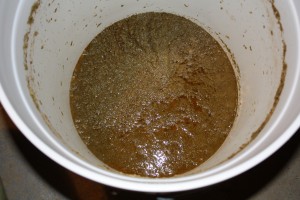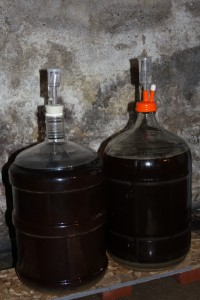Ben and I are attempting to make our homebrew as non-beer-drinker-friendly as possible. We are getting married in a month (…a month from tomorrow, exactly. Holy shit.) Anyway, the plan is to craft our Matrimoni-Ale with home-grown hops and lots of love and to have enough to send everyone home with a bottle. It seems strange that we would be friends with many non-beer drinkers, but family had to be invited too, or so I was told.
There are a number of differences between homebrewed and store-bought beer, some which may frighten off the uninitiated. Par example, sometimes there is a weensy bit of bonus beer sludge at the bottom of a bottle. In my opinion, not nearly as gross as a worm in bottom of my tequila, but what do I know, I won’t eat any dead animals, in bacon form or no.
When you let your homebrew sit and stew for a minute, a sizable amount of sediment settles out of it into a righteously gross sludge on the bottom. It’s composed of yeast, hop detritus and other nontoxic beer-making byproducts, but discovering a bit of this roughage in the bottom of the bottle really freaks some people out, especially if they’re used to crystal clear, ice cold, virtually tasteless, but very well-marketed American lagers. We are siphoning our beer off the yeast bed from one fermenter into another carboy a few times to have as little of this harmless but unappealing phenomenon as possible.
Homebrew rarely is as sparklingly clear as the store bought varieties, either. The suspended particles of yeast and sugars, etc can give it a little haze, and this happens more when bottle-conditioning the beer — that is, when you toss your yeast a little sugar to nosh on while in the bottle so they can provide the bubbliness — as the yeast creates the same byproducts it did the first time around. In an attempt to avoid seeing the lovely faces of our great-aunts and third cousins and dentists’ mailmen screwed up in distaste, we are kegging our beer, carbonating it with a CO2 tank, and then bottling it.
Another myth about homebrew I run across sometimes is that, well, it’s just gonna be bad. And even though it’s bad, you are my friend, so you have to drink the whole bottle. Now, I’m not going to jinx myself by bragging about how amazing this beer is going to be before I even taste it, but I will say I never let a friend drink a bad beer. There are a quadzillion things that can go wrong, even with this simple four-ingredient recipe…including using unfiltered tap water. But homebrewing websites deliver drops of wisdom that contradict each other (and much of what I said above), so in the end I just have to believe my OCD hand washing and Ben’s rigorous temp-taking regime plus the strength of our pure devotion to the beverage will combine in one truly fine brew.
The first batch can be kegged now, finally. You thought I was impatient when it came to filtering water for the brew kettle? You should see me dancing on my tip-toes now, when my first baby beer has already turned one month old! I will shortly be able to report on how the taste stands up to my high standards. If it doesn’t turn out, have no fear, there will be beer. Like an boozy boyscout, I am always prepared and there will be several kegs of (professionally made) craft beer at this celebration. I never dreamed of a big wedding with the white dress, the cooing doves, or the tiered cake, but I always assumed everyone would be loaded.



